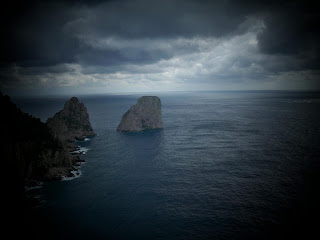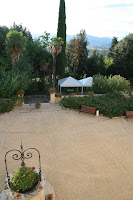It’s that time of year again, Eurochocolate! Every year in the fall for a week, the streets of Perugia fill up with chocolate and chocolate lovers alike. People flock to the historical center of town from all over the world see, taste and smell different kinds of chocolate. This year the weather has been slightly drizzly and chilly–nothing that one of the dozens of flavors of hot chocolate for sale in the streets won’t cure.
Month: October 2010
 No need to check your calendar. It’s not Halloween yet. The people dressed in Medieval costumes are actually the Medieval Cultures course students and professor. The class was transported back in time as they dined on traditional cuisine from recipes dating back hundreds of years. What was the setting for such a feast you ask? The ancient Roman theatrefrom the 1st century A.D. in Bevagna cleverly transformed into a Medieval house.
No need to check your calendar. It’s not Halloween yet. The people dressed in Medieval costumes are actually the Medieval Cultures course students and professor. The class was transported back in time as they dined on traditional cuisine from recipes dating back hundreds of years. What was the setting for such a feast you ask? The ancient Roman theatrefrom the 1st century A.D. in Bevagna cleverly transformed into a Medieval house.
Bevagna is home to Il Mercato delle Gaite, a market that prides itself on producing goods such as candles, bells, and paper using Medieval techniques and equipment. Students saw first-hand how paper was made thanks to the Master Paper-maker, Signor Proietti’s tour of his workshop. After the dinner feast and a tour of the town’s churches, it was time to come return to the 21st century and Perugia.

Congrats to Morgan Little from Lebanon Valley College for her winning photo this month from the Isle of Capri. Morgan will enjoy a free meal at Quattro Passi Pizzeria. Auguri, Morgan!
 This weekend Brother Sun vacationed with 39 Umbra Students, leaving the rest of Italy wet and without his warm company. Then again, Tuscany does tend to attract all sorts of visitors…
This weekend Brother Sun vacationed with 39 Umbra Students, leaving the rest of Italy wet and without his warm company. Then again, Tuscany does tend to attract all sorts of visitors…
Students spent Saturday morning in the undulating Cecina valley; home to the Etruscan and medieval haven Volterra. Students had an afternoon to wander the ancient stronghold’s tiny streets, and a few even chose to sample some of Tuscany’s more acquired tastes, such as cinghiale (wild boar) or Chianina (a type of beef unique to the region).
With stomachs pleasantly full students made via considerably winding roads for San Gimignano, whose looming towers and uneven piazzas pay perfect homage to a past usually seen only in Hollywood movies. A guided tour yielded several of the city’s countless secrets—old blood feuds or hospices visited by weary pilgrims centuries ago. And of course, one couldn’t leave San Gimignano without paying an indulgent visit to its world-famous gelateria. (If you ever go, try the pistachio!)
course, one couldn’t leave San Gimignano without paying an indulgent visit to its world-famous gelateria. (If you ever go, try the pistachio!)
Saturday evening found students lounging in a  quiet villa surrounded by rolling hills and sprawling vineyards laden with dark purple grapes; a perfect end to a long, rain-free day… After a light breakfast the following morning, the trusty coach and its deft driver brilliantly navigated the snaking hills of Tuscany to bring his charges to the dark walls of Monteriggione, one of Sienna’s oldest outposts responsible for guarding the once important Cassia trade road.
quiet villa surrounded by rolling hills and sprawling vineyards laden with dark purple grapes; a perfect end to a long, rain-free day… After a light breakfast the following morning, the trusty coach and its deft driver brilliantly navigated the snaking hills of Tuscany to bring his charges to the dark walls of Monteriggione, one of Sienna’s oldest outposts responsible for guarding the once important Cassia trade road.
Having toured the entire town, a feat easily accomplished in twenty minutes students ventured on to Sienna, as always an unforgettable experience. Green flags sporting proud geese (the mascot of this year’s Palio winner) waved triumphantly over exploring students, who had the afternoon to stop in tiny shops, restaurants, or the black and white-stoned wonder that is Sienna’s Duomo. Last views were taken from Sienna’s highest point, on a far reaching tower offering panoramas of the entire countryside.
Umbra Institute Art History Professor Adrian Hoch, working with previously unpublished documents, has written an intriguing paper on a fourteenth century tabernacle.
In mid-fourteenth century Florence, a man who later was declared a beato, the Blessed Chiarito del Voglia experienced visions which forecast the continuation of the Augustinian nunnery he had recently founded, called Santa Maria Regina Coeli. Drawing on both a contemporary painting in the Getty Museum and previously unpublished documents from the early seventeenth and  eighteenth centuries on this very local and quite unusual medieval Florentinebeato, Umbra Institute Art History Professor Adrian Hoch has written a significant paper which will be published in the journal of the prestigious Kunsthistorisches Institut in Florence.
eighteenth centuries on this very local and quite unusual medieval Florentinebeato, Umbra Institute Art History Professor Adrian Hoch has written a significant paper which will be published in the journal of the prestigious Kunsthistorisches Institut in Florence.
Hoch, who worked in the Getty Museum in 1985 and did the research for the acquisition report on the painting, discusses in her paper (provisionally titled: ” New Notices from the Florentine Baroque on the Trecento Chiarito Tabernacle) the personal eucharistic visions of the Blessed Chiarito del Voglia, which were literally and physically related to food, as represented in the painting done by Pacino di Bonaguida. The Chiarito Tabernacle will be part of an exhibition on Giotto and early fourteenth century Florentine painting scheduled to open at the Getty Museum in 2012.
The Umbra Institute congratulates Professor Hoch for her work and for her dedication to both teaching and continuing scholarship.
 Though the tents that shelter all the stands haven’t started appearing yet in Corso Vannucci, the Eurochocolate “Festival” isn’t far away. Perugia’s famous for that felicitous marriage of cocoa, milk, and sugar because of the long tradition of chocolate here (beginning with the Perugina Confectionery Company, born over a hundred years ago), and the city rightly becomes the temporary capital of dark sweetness every October.But this year, as for the past ten years, there will be an alternative to the fast-food approach to chocolate.
Though the tents that shelter all the stands haven’t started appearing yet in Corso Vannucci, the Eurochocolate “Festival” isn’t far away. Perugia’s famous for that felicitous marriage of cocoa, milk, and sugar because of the long tradition of chocolate here (beginning with the Perugina Confectionery Company, born over a hundred years ago), and the city rightly becomes the temporary capital of dark sweetness every October.But this year, as for the past ten years, there will be an alternative to the fast-food approach to chocolate.
Altrocioccolato (literally “another chocolate”), a festival organized to promote fair trade brands, will be held in the nearby city of Castiglione del Lago from October 15th to 17th. In addition to free concerts and seminars about fair trade, the festival will feature (of course!) fair trade chocolate from all over the world.
Yesterday night the Birraio hosted the Umbra Institute’s welcome back aperitivo. Students tired from all of their Fall Break travel were able to kick back on the Birraio’s comfy couch-seats and have a bite to eat while recounting their adventures in foreign capitals. The evening was enlivened by an unexpected power outage: the lights went but the candles stayed on, creating an even better atmosphere for travel tales. Next up on the Umbra calendar: next week’s Cheese Workshop (sign up with Zach or Ian).
 This could have been the name of last night’s lecture…had it been a lecture! Instead it was the Umbra Institute’s Pizza Workshop, a hot-baked mix of the history and biochemistry of pizza, followed by the main course, the pizza itself. Fifteen Umbra students followed staff member Zach Nowak down into the medieval Via della Viola neighborhood to the pizzeria “Pizza e Musica,” located in a nook (a former convent).
This could have been the name of last night’s lecture…had it been a lecture! Instead it was the Umbra Institute’s Pizza Workshop, a hot-baked mix of the history and biochemistry of pizza, followed by the main course, the pizza itself. Fifteen Umbra students followed staff member Zach Nowak down into the medieval Via della Viola neighborhood to the pizzeria “Pizza e Musica,” located in a nook (a former convent).

Pizza e Musica, like many “neighborhood pizzerias,” has no sign, but it does have heart. Head pizzaiolo (pizza-maker) Felice, a Neapolitan through-and-through, welcomed the students into the pizzeria. Nowak took a turn explaining some of the history of the pizza (including a digression on how the Pizza Margherita supposedly got its name) and how the dough rises.
This was followed by the geography of heat in the oven: every pizzaiolo needs to know where the warm and cold spots are in his or her oven, and how to use these differences in heat to make all the pizzas come out at the same time.
 Arguably (well, actually no one present would have argued his) the best part of the night was the practical side of the workshop. Three students had the chance to get behind the marble pizza counter and stretch out their dough, adding toppings galore. Despite their inexperience, all three made up delicious pizzas for their classmates. And after that, everyone sat down and had yet another pizza for a perfect, tomato-topped conclusion to the evening.
Arguably (well, actually no one present would have argued his) the best part of the night was the practical side of the workshop. Three students had the chance to get behind the marble pizza counter and stretch out their dough, adding toppings galore. Despite their inexperience, all three made up delicious pizzas for their classmates. And after that, everyone sat down and had yet another pizza for a perfect, tomato-topped conclusion to the evening.
In the photos: Devon Forbes, Matt Wischerth, and Emerson Oronte
.

